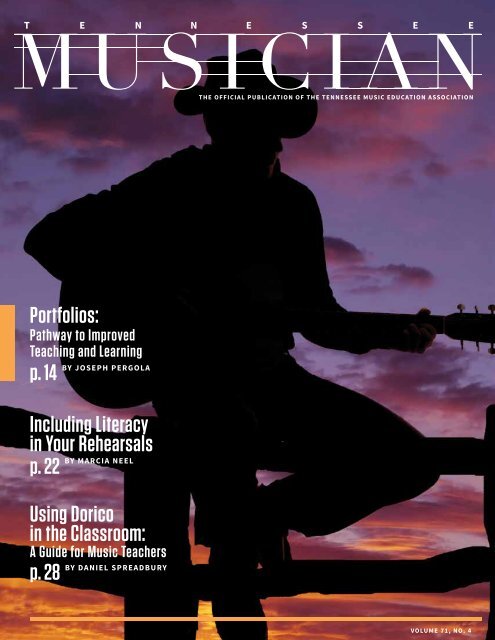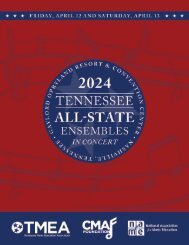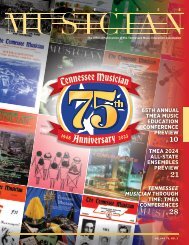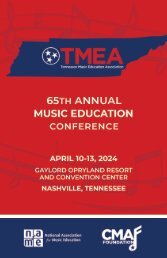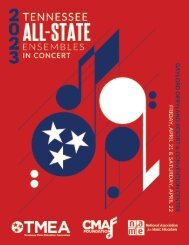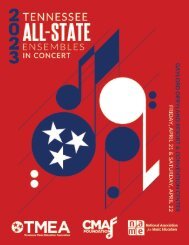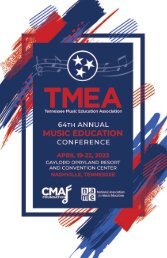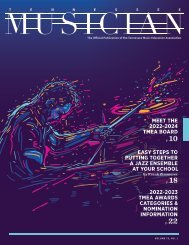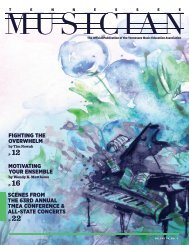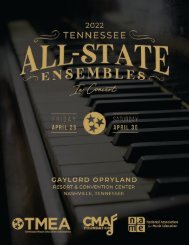TN Musician Vol. 71 No. 4
You also want an ePaper? Increase the reach of your titles
YUMPU automatically turns print PDFs into web optimized ePapers that Google loves.
THE OFFICIAL PUBLICATION OF THE TENNESSEE MUSIC EDUCATION ASSOCIATION<br />
Portfolios:<br />
Pathway to Improved<br />
Teaching and Learning<br />
p. 14<br />
BY JOSEPH PERGOLA<br />
Including Literacy<br />
in Your Rehearsals<br />
BY MARCIA NEEL<br />
p. 22<br />
Using Dorico<br />
in the Classroom:<br />
A Guide for Music Teachers<br />
p. 28<br />
BY DANIEL SPREADBURY<br />
VOLUME <strong>71</strong>, NO. 4
TENNESSEE MUSICIAN<br />
EDITORIAL STAFF<br />
MICHAEL W. CHESTER<br />
Managing Editor and Advertising Manager<br />
JUSTIN T. SCOTT<br />
Associate Editor<br />
ANNA LAURA WILLIAMS<br />
E-Newsletter Editor<br />
PUBLISHED BY SLATE GROUP<br />
6024 45th Street<br />
Lubbock, Texas 79407<br />
(800) 794-5594 office<br />
(806) 794-1305 fax<br />
RICO VEGA<br />
Director of Creative Services<br />
IAN SPECTOR<br />
Account Executive<br />
Place non-member subscription and single copy orders<br />
at TMEA, 129 Paschal Drive, Murfreesboro, Tennessee<br />
3<strong>71</strong>28 or e-mail to editor@tnmea.org.<br />
All editorial materials should be sent to: Michael<br />
Chester, Managing Editor (615-904-67<strong>71</strong> ext. 31600)<br />
e-mail: editor@tnmea.org. Submit materials by e-mail<br />
in Microsoft Word format.<br />
TABLE OF CONTENTS | 2019 | VOLUME <strong>71</strong>, NO. 4<br />
PRELUDE – A MESSAGE FROM THE EDITOR 6<br />
Michael Chester<br />
TMEA PRESIDENT’S MESSAGE 8<br />
Lafe Cook<br />
BY THE NUMBERS/VERBATIM 10<br />
Lisa Burden<br />
FEATURED ARTICLES<br />
PORTFOLIOS:<br />
PATHWAY TO IMPROVED TEACHING AND LEARNING 14<br />
Joseph Pergola<br />
INCLUDING LITERACY IN YOUR REHEARSALS 22<br />
Marcia Neel<br />
USING DORICO IN THE CLASSROOM:<br />
A GUIDE FOR MUSIC TEACHERS 28<br />
Daniel Spreadbury<br />
SCENES FROM THE 62ND ANNUAL TMEA PD CONFERENCE 30<br />
TENNESSEE MUSICIAN ADVERTISER INDEX 34<br />
TMEA BACK THEN 36<br />
Advertising: Information requests and ad orders<br />
should be directed to: Michael Chester, Editor-in-Chief<br />
(615-904-67<strong>71</strong> ext. 31600) e-mail: editor@tnmea.org.<br />
All advertising information is on the TMEA website,<br />
www.tnmea.org.<br />
Deadlines for advertisement orders and editorial<br />
materials: Issue <strong>No</strong>. 1 – Deadline: August 15 (in home<br />
delivery date October 15); Issue <strong>No</strong>. 2 – Deadline:<br />
October 15 (in home delivery date December 15); Issue<br />
<strong>No</strong>. 3 – Deadline: December 15 (in home delivery date<br />
March 15); Issue <strong>No</strong>. 4 – Deadline: February 15 (in home<br />
delivery date May 15)<br />
Tennessee <strong>Musician</strong> is copyrighted. Reproduction in<br />
any form is illegal without the express permission<br />
of the editor.<br />
Postmaster: Send address changes to: Tennessee<br />
<strong>Musician</strong>, c/o National Association for Music<br />
Education (NAfME), 1806 Robert Fulton Drive, Reston,<br />
VA 20191-4348.<br />
<strong>No</strong>n-Profit 501(c)(3) Organization U.S. Postage Paid at<br />
Lubbock, Texas. ISSN Number 0400-3332; EIN number<br />
20-3325550<br />
THE TENNESSEE MUSICIAN<br />
THE OFFICIAL PUBLICATION OF THE TENNESSEE MUSIC EDUCATION ASSOCIATION<br />
The Tennessee Music Education Association (TMEA) was officially formed in 1945 as a voluntary,<br />
non-profit organization representing all phases of music education at all school levels. The mission<br />
of TMEA is to promote the advancement of high quality music education for all. Active TMEA<br />
membership is open to all persons currently teaching music and others with a special interest or<br />
involvement in music education. Collegiate membership and retired memberships are available.<br />
Membership applications are available on the TMEA website, www.tnmea.org.<br />
The Tennessee <strong>Musician</strong> was founded in 1948 with J. Clark Rhodes appointed by the TMEA Board of<br />
Control as inaugural editor. Tennessee <strong>Musician</strong> was preceded by an earlier publication, Tennessee<br />
Music Editors’ Downbeat, which was discontinued by the TMEA Board of Control at the spring board<br />
meeting, held in Chattanooga, Tennessee in 1948. Tennessee <strong>Musician</strong> is published by Slate Group –<br />
Lubbock, Texas and is mailed to members four times each year at an annual subscription rate of $6.00<br />
(included in dues). <strong>No</strong>n-member subscription rate (includes S&H): $30.00 per school year; single<br />
copies: $10.00 per issue<br />
p. 14 p. 22 p. 28
TMEA BOARD AND COUNCIL<br />
NATIONAL EXECUTIVE BOARD<br />
(National Association for Music Education)<br />
SOUTHERN DIVISION PRESIDENT:<br />
Dian Eddleman<br />
deddleman@usjbruins.org<br />
TMEA OFFICERS<br />
TMEA EXECUTIVE DIRECTOR:<br />
Ron Meers<br />
execdirector@tnmea.org.org<br />
TMEA PRESIDENT:<br />
Lafe Cook<br />
president@tnmea.org<br />
TMEA PRESIDENT-ELECT:<br />
Alexis Yatuzis-Derryberry<br />
pres-elect@tnmea.org<br />
TMEA IMMEDIATE PAST-PRESIDENT:<br />
Johnathan Vest, Ed. D.<br />
past-president@tnmea.org<br />
BOARD OF DIRECTORS<br />
TMEA STATE GENERAL MUSIC CHAIR:<br />
Linzie Mullins<br />
linziemullins9@gmail.com<br />
TMEA STATE CHORAL CHAIR:<br />
Reachel Hudgins<br />
choralchair@tnmea.org<br />
TMEA STATE ORCHESTRA CHAIR:<br />
Anna Maria Miller<br />
orchestrachair@tnmea.org<br />
TMEA STATE BAND CHAIR:<br />
Megan Christian<br />
megan.christian@knoxschools.org<br />
TMEA STATE HIGHER EDUCATION CHAIR:<br />
Barry Kraus, DMA<br />
higheredchair@tnmea.org<br />
TMEA STATE COLLEGIATE NAFME CHAIR:<br />
David Royse, Ph. D.<br />
droyse@utk.edu<br />
TMEA SOCIETY FOR MUSIC TEACHER EDUCATION/<br />
RESEARCH CHAIR:<br />
Jamilia McWhirter, Ph. D.<br />
jamila.mcwhirter@mtsu.edu<br />
TMEA STATE EDUCATIONAL TECHNOLOGY CHAIR:<br />
John Womack<br />
webmaster@tnmea.org<br />
TMEA ADVOCACY AND GOVERNMENT RELATIONS CHAIR:<br />
Christopher Dye, Ed. D.<br />
christopher.dye@mtsu.edu<br />
TMEA PUBLICATIONS EDITOR AND<br />
ADVERTISING MANAGER:<br />
Michael Chester<br />
editor@tnmea.org<br />
TMEA PUBLICATIONS ASSOCIATE EDITOR:<br />
Justin Scott<br />
justin.scott@tcsedu.net<br />
TMEA COUNCIL<br />
WTGMEA PRESIDENT:<br />
Frances Miller<br />
wtgmeamemphis@yahoo.com<br />
WTGMEA PRESIDENT-ELECT:<br />
Ray Mullins<br />
wtgmeamemphis@yahoo.com<br />
WTVMEA PRESIDENT:<br />
Emily Taylor<br />
etaylor@colliervilleschools.org<br />
WTVMEA PRESIDENT-ELECT:<br />
Sharon Morris<br />
smorris@lced.net<br />
WTSBOA PRESIDENT:<br />
Ollie Liddell<br />
ollie_liddell@hotmail.com<br />
WTSBOA PRESIDENT-ELECT:<br />
Jennifer Cupples<br />
jennifer.cupples@chestercountyschools.org<br />
MTGMEA PRESIDENT:<br />
Rachel Lapinski<br />
lapinskir@rcschools.net<br />
MTGMEA PRESIDENT-ELECT:<br />
Corynn York<br />
corynn.york@cityschools.net<br />
MTVA PRESIDENT:<br />
Lia Holland<br />
liaholland@mtcscougars.org<br />
MTVA PRESIDENT-ELECT:<br />
Gerald Patton<br />
pattong@rcschools.net<br />
MTSBOA PRESIDENT:<br />
Debbie Burton<br />
president@mtsboa.org<br />
MTSBOA PRESIDENT-ELECT:<br />
Justin Scott<br />
justin.scott@tcsedu.net<br />
ETGMEA PRESIDENT:<br />
Marcus Smith<br />
marcus.smith@knoxschools.org<br />
ETGMEA PRESIDENT-ELECT:<br />
Amanda McMahan<br />
amanda.mcmahan@knoxschools.org<br />
ETVA PRESIDENT:<br />
Stephanie Coker<br />
scoker@acs.ac<br />
ETVA PRESIDENT-ELECT:<br />
Deborah Gouge<br />
debgouge@charter.net<br />
ETSBOA PRESIDENT:<br />
Alan Hunt<br />
ahunt@bradleyschools.org<br />
ETSBOA PRESIDENT-ELECT:<br />
Donald Benton<br />
dbenton@bradleyschools.org<br />
CONFERENCE MANAGEMENT TEAM<br />
TMEA CONFERENCE CO-CHAIR:<br />
Brad Turner<br />
brad.turner@acsk-12.org<br />
TMEA CO-CONFERENCE CHAIR:<br />
Paul Waters<br />
paulwaters.tmea@gmail.com<br />
TMEA CONFERENCE EXHIBITS CHAIR:<br />
Jo Ann Hood<br />
jhood10105@aol.com<br />
TMEA CONFERENCE REGISTRATION CHAIR:<br />
Mark Garey<br />
mgarey86@comcast.net<br />
TMEA CONFERENCE PERFORMANCE GROUP CHAIR:<br />
John Mears<br />
mearsj@rcschools.net<br />
ALL-STATE MANAGEMENT TEAM<br />
<strong>TN</strong> ALL-STATE CHORAL GENERAL CHAIR:<br />
Amanda Ragan<br />
aragan@ortn.edu<br />
<strong>TN</strong> ALL-STATE INSTRUMENTAL GENERAL CHAIR:<br />
Todd Shipley<br />
todd.shipley@mnps.org<br />
ENSEMBLE CHAIRS<br />
TREBLE HONOR CHOIR CHAIR:<br />
Tiffany Barton<br />
tntreblechoir@gmail.com<br />
<strong>TN</strong> ALL-STATE SATB CHOIR CHAIR:<br />
Amanda Short<br />
amandalovellshort@gmail.com<br />
<strong>TN</strong> ALL-STATE SSAA CHOIR CHAIR:<br />
Kelly Davenport<br />
davenportK@wcde.org<br />
<strong>TN</strong> ALL-STATE TTBB CHOIR CHAIR:<br />
Lauren Ramey<br />
lauren.ramey@wcs.edu<br />
<strong>TN</strong> ALL-STATE 9TH–10TH GRADE STRING<br />
ORCHESTRA CHAIR:<br />
Nichole Pitts<br />
pitts_stephanie@hcde.org<br />
<strong>TN</strong> ALL-STATE 11TH–12TH GRADE SYMPHONIC<br />
ORCHESTRA CHAIR:<br />
Gary Wilkes<br />
gwilkes428@gmail.com<br />
<strong>TN</strong> ALL-STATE 9TH–10TH GRADE CONCERT BAND CHAIR:<br />
Carter <strong>No</strong>blin<br />
noblinc@wcschools.com<br />
<strong>TN</strong> ALL-STATE 11TH–12TH GRADE CONCERT BAND CHAIR:<br />
J.R. Baker<br />
john.baker@rcstn.net<br />
<strong>TN</strong> ALL-STATE JAZZ BAND CHAIR:<br />
Cord Martin<br />
corderyl.martin@gmail.com<br />
PROJECT CHAIRS<br />
TMEA JAZZ EDUCATION POLICY CHAIR:<br />
Richard Ripani, Ph. D.<br />
richard.ripani@mnps.org<br />
TMEA MUSIC MERCHANTS INDUSTRY CHAIR:<br />
Rick DeJonge<br />
rick.dejonge@khsmusic.com<br />
TMEA WEBMASTER:<br />
John Womack<br />
webmaster@tnmea.org<br />
TMEA TRI-M CHAIR:<br />
Anna Laura Williams<br />
anna.laura.williams@outlook.com<br />
TMEA MUSIC IN OUR SCHOOLS MONTH CHAIR:<br />
Tiffany Barton<br />
tntreblechoir@gmail.com<br />
TMEA RETIRED TEACHERS CHAIR:<br />
Bobby Jean Frost<br />
bjfrost@aol.com<br />
2 | TENNESSEE MUSICIAN | 2019 | <strong>Vol</strong>ume <strong>71</strong>, <strong>No</strong>. 4
4 | TENNESSEE MUSICIAN | 2019 | <strong>Vol</strong>ume <strong>71</strong>, <strong>No</strong>. 4
Tennessee Music Education Association | www.tnmea.org | 5
PRELUDE - A MESSAGE FROM THE EDITOR<br />
Michael Chester || Stewarts Creek High School<br />
S<br />
ummer, as we all know, seems to be<br />
the time for reflection for many<br />
teachers. The familiar grind has<br />
come to a temporary halt and with that<br />
void comes some uninterrupted time to<br />
contemplate. Lately, I’ve been thinking<br />
a lot about the state of education and<br />
in general the constant push for higher<br />
and higher achievement test scores, the<br />
demand for more rigorous education<br />
standards, more emphasis placed on<br />
STEM, and the continuous invasion<br />
on the very sacred thing we all call<br />
instructional time. I use the term invasion<br />
to be intentionally provocative. There<br />
seems to be an increase in the workload<br />
of the non-instructional aspects required<br />
of teachers today. This inevitably creates<br />
two problems – a loss of instructional<br />
time and a loss of the much-needed<br />
emotional energy and “head-space” to be<br />
an effective educational leader.<br />
All of this comes with a very high cost.<br />
Students seem to be more stressed out<br />
than ever, heavily medicated, and lack<br />
necessary coping skills because of the<br />
various parenting behaviors in today’s<br />
culture of hypersensitivity. Yet we<br />
demand more from students, now more<br />
than ever. Skills that students in fourth<br />
grade were expected to master in past<br />
decades have today been replaced with<br />
skill sets and achievements that were<br />
expected from freshmen and sophomores<br />
in high school. We simply can’t end there.<br />
<strong>No</strong>w the expectation is for students in late<br />
elementary school to start thinking about<br />
college. High school students are expected<br />
to participate in college dual-enrollment<br />
6 | TENNESSEE MUSICIAN | 2019 | <strong>Vol</strong>ume <strong>71</strong>, <strong>No</strong>. 4
classes to get a head start for college. While<br />
this level of expectation has some merits, it<br />
also begs the question as to whether or not<br />
the increase in academic rigor is healthy<br />
for students. The educational-industrial<br />
complex, with its special interest lobbyists,<br />
have for years championed an increase in<br />
higher and higher academic standards<br />
for students and what they should know<br />
upon graduation. Yet it seems unclear as<br />
to whether or not any determination for<br />
the developmental, social, and emotional<br />
maturity and growth of students was ever<br />
factored. Just because the standards have<br />
changed to include skills once reserved for<br />
high school or middle school students to<br />
be taught to elementary school students<br />
doesn’t mean they are ready for it.<br />
This is where the importance of being<br />
a music educator is ever so critical, today<br />
more than ever. Our classes and those in<br />
the other arts disciplines give students<br />
a much-needed respite. Moreover, our<br />
classes give students the tools to express<br />
themselves in an appropriate matter<br />
and to deal with adversity through<br />
perseverance. It would be hard to imagine<br />
if our profession was caught-up in<br />
the current trends of education. If the<br />
emphasis in K-12 music education was<br />
simply all about the end product, perhaps<br />
the landscape would be drastically<br />
different. To think that middle school<br />
students who are just being introduced<br />
to performance ensemble classes would<br />
be expected to master musical skills once<br />
reserved for high school students would<br />
have dire consequences. There would<br />
only be a select few who could achieve<br />
those skills, and the rest would fall by<br />
the wayside.<br />
As music educators, we seem to be<br />
lucky in that we are masters of our own<br />
fate. We have been fortunate that despite<br />
all of the changes to our curriculum and<br />
standards for music education, that our<br />
standards are still grade-level appropriate<br />
for students. Even with all of the changes<br />
in technology and even the constant<br />
evolution of arts education standards for<br />
music, we have always managed to take<br />
into consideration appropriate standards<br />
for music education based on the grade and<br />
developmental levels of the students.<br />
There was once a time when students<br />
learned more than just about the subject<br />
matter that was being presented to them.<br />
Schools were still charged with making<br />
sure that students also had an education<br />
in character, conduct, and civility. While<br />
teachers of today are certainly as skilled,<br />
and in some ways perhaps more prepared<br />
to take on the task of education, than those<br />
of their predecessors, they just are not<br />
afforded the opportunities to instill the<br />
fundamental values as they once could<br />
because so much of the instructional<br />
time has to be devoted to “the test.” For<br />
better or for worse, that job now falls<br />
We have always<br />
managed to take<br />
into consideration<br />
appropriate<br />
standards for music<br />
education based<br />
on the grade and<br />
developmental levels<br />
of the students.<br />
onto the shoulders of music educators.<br />
Our classrooms may be the last bastions<br />
of hope for the many students that we are<br />
privileged to work with. Today’s students<br />
face an uncertain future in a drastically<br />
changing and polarizing landscape.<br />
Despite all of this, I believe that students<br />
who participate in music classes will<br />
ultimately have an advantage in the world,<br />
due in no small part to some of the most<br />
valuable skill sets that were instilled by a<br />
music educator.<br />
Michael Chester | Managing Editor<br />
Tennessee Music Education Association | www.tnmea.org | 7
TMEA PRESIDENT’S MESSAGE<br />
Lafe Cook || Dobyns-Bennett High School<br />
T<br />
hroughout my career, I’ve learned<br />
that great teachers use the<br />
summer to both relax and unwind<br />
from the school year and to reflect upon<br />
and plan for the future. I know that I’m<br />
planning on trying to do both of those<br />
things as much as I can this summer. By<br />
the time you read this message, summer<br />
will be in full swing, and I hope that<br />
you are enjoying some much-needed<br />
time off. As TMEA President, I have the<br />
added responsibility of also reflecting<br />
on our growth and achievements as<br />
an association.<br />
As I look back at the progress we have<br />
made, I am also keenly aware that there<br />
is still much to do. In thinking about<br />
this, my thoughts have turned back to<br />
our TMEA Professional Development<br />
Conference this past April. It was quite<br />
a display of just how fortunate the<br />
students of Tennessee are to have such<br />
great music educators. The selected<br />
TMEA Performing Ensembles continue<br />
It’s time to let the<br />
leadership know that<br />
there is a significant<br />
segment of our<br />
Tennessee schools<br />
who serve a diverse<br />
socio-economic<br />
student population<br />
who struggle to<br />
maintain affiliations<br />
with our regional and<br />
state associations<br />
due to the cost of<br />
membership<br />
at the national level.<br />
to display a high caliber of musicianship<br />
that represents the high standards<br />
of Tennessee music educators. In<br />
addition, the TMEA Spotlight Chamber<br />
Ensemble performances also highlighted<br />
excellence in teaching with a diverse<br />
mixture of traditional and non-traditional<br />
ensembles. And of course, our Tennessee<br />
All-State Ensembles keep raising the bar<br />
higher and higher with their outstanding<br />
conductors and performances. On<br />
top of all that, we have a professional<br />
development conference that brings<br />
together so many exceptional leaders<br />
in so many facets of contemporary<br />
music education.<br />
Reflecting upon those four days in<br />
April, I think about the many people<br />
of our association who also volunteer<br />
and serve TMEA year-round in order<br />
to ensure an excellent experience for<br />
our membership, and for our students.<br />
It can sometimes be easy to take these<br />
individuals for granted as many of us are<br />
not aware of how much goes on behind<br />
the scenes to make our experience in<br />
April something we look forward to each<br />
year. I am so grateful and thankful to the<br />
members of the TMEA Board and Council<br />
and to everyone who volunteers for our<br />
TMEA. Words truly cannot express how<br />
much your leadership means to me and to<br />
all of us across Tennessee.<br />
It has been a very productive year for<br />
TMEA. I am happy to report that our<br />
association has made some significant<br />
progress towards some goals in our<br />
strategic plan. This year we have once<br />
again partnered with the Country Music<br />
Association Foundation. Their unyielding<br />
support of music education in Tennessee<br />
is unparalleled, and we could not thank<br />
them enough for their generosity. As<br />
a result, we were able to launch our<br />
first TMEA Regional Professional<br />
Development Grant, which awarded<br />
more than $8,000.00 for professional<br />
development grant money to the<br />
following organizations:<br />
• West Tennessee General Music<br />
Association<br />
• East Tennessee American Orff-<br />
Schulwerk Association<br />
• Tennessee Chapter of Collegiate<br />
National Association for Music<br />
Education<br />
• Rutherford County Schools<br />
• Tennessee Bandmasters Association<br />
We continue to flourish under the<br />
watchful auspices of our team at Milsaps-<br />
Gowan and the ArtsEd Tennessee. I<br />
can’t stress how important it is to have<br />
lobbyists who are working on our behalf<br />
for arts education in Tennessee and who<br />
are keeping a watchful eye on legislation<br />
that could have a drastic impact on what<br />
we do. I feel good about what TMEA has<br />
done and is currently doing for our music<br />
educators. Yet there are still some things<br />
that I think we should aim to accomplish<br />
as we head into the next school year.<br />
At the conference, I had the pleasure to<br />
attend many of the area caucus meetings.<br />
There were many productive topic<br />
discussions. One of the common threads<br />
that each area shared was the future<br />
of TMEA’s relationship with NAfME.<br />
There were many points of pros and cons.<br />
8 | TENNESSEE MUSICIAN | 2019 | <strong>Vol</strong>ume <strong>71</strong>, <strong>No</strong>. 4
In thinking about what is truly best for<br />
Tennessee, I have decided to make a rather<br />
bold proposal to NAfME. It’s time to let the<br />
leadership know that there is a significant<br />
segment of our Tennessee schools who<br />
serve a diverse socio-economic student<br />
population who struggle to maintain<br />
affiliations with our regional and state<br />
associations due to the cost of membership<br />
at the national level.<br />
What your TMEA leadership is going<br />
to propose to NAfME is for a complete or<br />
partial waiver of NAfME membership fees<br />
for first time members teaching in lowincome<br />
schools. Members of the TMEA<br />
Board will be busy this summer drafting a<br />
proposal to submit to NAfME Leadership<br />
at the National Leadership Assembly in<br />
late June. What will come of this proposal<br />
remains as of yet to be seen. What is<br />
abundantly clear to me as TMEA President<br />
is that there is a segment of our students<br />
in Tennessee who are not being given<br />
access to events like regional honor bands,<br />
choirs, and orchestras, simply because<br />
their school systems or their teachers<br />
do not have the means to fund their<br />
NAfME membership.<br />
We all know that anything that involves<br />
institutional change can be painfully slow.<br />
What is important now is not recognizing<br />
the glacial pace of progress but rather the<br />
fact that things that are of interest and<br />
importance to Tennessee music educators<br />
are being addressed, not just for the here<br />
and now but for the long game ahead.<br />
I will keep you apprised of our progress.<br />
In the meantime, I hope that your summer<br />
is both rewarding and relaxing.<br />
Lafe Cook | TMEA President<br />
Tennessee Music Education Association | www.tnmea.org | 9
BY THE NUMBERS | VERBATIM<br />
Lisa Burden<br />
TOP 10<br />
SOFT<br />
SKILLS<br />
Any music educator who has taught for<br />
a number of years can recount former<br />
students who have achieved many<br />
successes. They can also share moments,<br />
letters, emails, and phone calls with these<br />
students who have said that they, as a<br />
music educator, attributed to this success.<br />
They won’t discuss the scale that was<br />
taught or the technique of the voice or<br />
instrument. Rather, they will talk about<br />
the soft skills that they learned from that<br />
educator in their class.<br />
A 2016 LinkedIn survey of 291 hiring<br />
managers in the U.S. revealed that 59%<br />
of them believe that soft skills are difficult<br />
to find.<br />
LinkedIn also analyzed the soft skills<br />
listed on the profiles of members who<br />
changed employers between June 2014<br />
and June 2015 to identify the most soughtafter<br />
soft skills among employers. These 10<br />
topped the list:<br />
ORGANIZATION<br />
ALWAYS<br />
PUNCTUAL<br />
SOCIAL SKILLS<br />
INTERPERSONAL<br />
COMMUNICATION<br />
FRIENDLY<br />
PERSONALITY<br />
2 4 6 8 10<br />
56.5% 55.9% 55.8% 55.0% 54.6%<br />
1<br />
COMMUNICATION<br />
3<br />
5 7 9<br />
57.9% 56.4% 55.8% 55.0% 54.9%<br />
TEAMWORK<br />
CRITICAL<br />
THINKING<br />
CREATIVITY<br />
ADAPTABILITY<br />
Berger, Guy. Data Reveals the Most In-Demand Soft Skills Among Candidates. 30 Aug. 2016, business.<br />
linkedin.com/talent-solutions/blog/trends-and-research/2016/most-indemand-soft-skills.<br />
VERBATIM<br />
“I think the most valuable thing<br />
she (Beckye Thomas) taught me<br />
was having a talent and a passion<br />
for music is a beautiful thing but<br />
having the work ethic and that<br />
passion to match it is really when<br />
you can find magic.”<br />
-Kelsea Ballerini<br />
on how retired Knoxville Central<br />
teacher, Beckye Thomas, impacted her<br />
“My high school band director,<br />
Mr. Koch, pushed me to reach my<br />
full potential. I knew all along that<br />
I wouldn’t build a career around<br />
playing the tuba, but he never allowed<br />
me to think like that. As I slacked<br />
and rebelled, he never let me forget<br />
that I possessed a special talent. I<br />
hated it at the time but now I’m able<br />
to reflect — he taught me self-respect<br />
and discipline in a firm but kind<br />
way. I am forever grateful to him for<br />
challenging me.”<br />
-Gwen Schroeder<br />
TED Post-Production Manager<br />
“My high school band director, Virgil<br />
Spurlin. . . seemed to instinctively<br />
know. . . what questions to ask to<br />
find out what was really going on<br />
in their lives. He also was always<br />
looking for things that young people<br />
could do besides play music. We<br />
put on the state band festival every<br />
year, for example, and he let lots<br />
of us help. And he taught us basic<br />
organizational skills and how to<br />
allocate resources and move things<br />
around. But always he was trying to<br />
find things that people were good<br />
at. He thought that everybody was<br />
good at something and if he just<br />
looked hard enough he could find<br />
it, he could convince them of it, and<br />
he could raise their aspirations and<br />
their hopes.”<br />
– President Bill Clinton<br />
10 | TENNESSEE MUSICIAN | 2019 | <strong>Vol</strong>ume <strong>71</strong>, <strong>No</strong>. 4
Tennessee Music Education Association | www.tnmea.org | 11
12 | TENNESSEE MUSICIAN | 2019 | <strong>Vol</strong>ume <strong>71</strong>, <strong>No</strong>. 4
Tennessee Music Education Association | www.tnmea.org | 13
PORTFOLIOS:<br />
Pathway to Improved<br />
Teaching and Learning<br />
Joseph Pergola<br />
T<br />
hankfully, the education profession<br />
is once again focusing on the<br />
importance of “assessment”. The<br />
first big push for embedded assessment<br />
accompanied the introduction of the<br />
National Standards which called for the<br />
systematic assessment of student learning.<br />
The newest education initiatives such<br />
as Common Core, Annual Professional<br />
Performance Reviews and others<br />
designed to improve student learning,<br />
have once again brought assessment<br />
front and center as a critical element in<br />
the teaching/learning process. It’s time<br />
to re-examine portfolio assessment<br />
in light of today’s push for evidence<br />
of learning.<br />
Comprehensive assessment is the<br />
most significant factor in the pursuit<br />
for better student learning. Improved<br />
learning is totally dependent on<br />
successful teaching and successful<br />
teaching is dependent on improved<br />
teacher instruction! Successful teachers<br />
continually evaluate the teaching and<br />
learning process. They determine the<br />
learning level of their students and<br />
refine their instruction for greater<br />
success. Improved student learning is an<br />
out-growth of information necessary to<br />
judge student understanding, measure<br />
student progress and examine student<br />
thought processes. Teachers who are<br />
successful question what they can do<br />
differently, what new materials they can<br />
use and what new instructional approach<br />
they can take for improved results.<br />
In other words, successful teachers<br />
assess learning because assessment<br />
improves instruction.<br />
There are many forms of assessment<br />
and many assessment tools. Classroom<br />
assessment can include a wide range of<br />
options. These options can be divided<br />
into two (2) categories. Most assessment<br />
proponents recommend “Formative<br />
Assessment” which is on-going or<br />
embedded assessment, continually<br />
observes student learning and evaluates<br />
the scope and pace of student learning<br />
so the teacher can reflect on their<br />
instruction and refine their teaching.<br />
Assessment that determines student<br />
competency only at the conclusion of<br />
a specific instructional period of time<br />
is “Summative Assessment”. This form<br />
of assessment is used to determine<br />
if students have mastered specific<br />
competencies and identify instructional<br />
areas in need of attention. The critical<br />
element in both forms of assessment<br />
is the tool or tools used to administer<br />
the assessment.<br />
There are many assessment vehicles<br />
available. Most assessment vehicles<br />
provide good information about<br />
specific aspects of student learning at<br />
a specific point in time. For example;<br />
a “rubric” rates knowledge or skill<br />
about a specific instructional topic.<br />
An “observation report” supplies<br />
data about the specific endeavor<br />
being observed. The only assessment<br />
tool that contains multiple forms of<br />
assessment is “Portfolio Assessment”.<br />
It is both simultaneously formative<br />
and summative. Portfolio assessment<br />
captures the process of learning and<br />
contains samples that exemplify<br />
a student’s knowledge of essential<br />
learning at various stages of instruction.<br />
SO WHAT IS A PORTFOLIO?<br />
A portfolio is an assessment vehicle<br />
that contains a purposefully selected<br />
collection of student work designed to<br />
show student effort, document student<br />
progress, reveal student strengths,<br />
create awareness of student weaknesses<br />
and informs the teacher, student and<br />
parent of the status and progress of a<br />
student. It is not just a pile of student<br />
work accumulated over a semester or<br />
year. Portfolios enhance the assessment<br />
process by revealing the range of student<br />
14 | TENNESSEE MUSICIAN | 2019 | <strong>Vol</strong>ume <strong>71</strong>, <strong>No</strong>. 4
Tennessee Music Education Association | www.tnmea.org | 15
skill and understanding. Portfolios align<br />
assessment with specific student learning<br />
objectives and overall instructional goals.<br />
HOW DO PORTFOLIOS BENEFIT STUDENTS?<br />
The use of portfolios in the assessment<br />
process give students an opportunity to<br />
demonstrate and record the knowledge<br />
and skill they have gained. Portfolios<br />
help develop student responsibility for<br />
their own learning by requiring students<br />
to contribute specific appropriate<br />
content. It requires students to critique<br />
their own work, thereby reinforcing<br />
learning. This process of demonstrating<br />
strengths and recognizing weaknesses<br />
motivates students to achieve at a higher<br />
level. Student participation in portfolio<br />
assessment promotes life-long learners.<br />
WHAT IS THE BENEFIT OF PORTFOLIO<br />
ASSESSMENT TO THE TEACHER?<br />
Portfolio assessment makes<br />
instruction more productive because<br />
it helps teachers measure their own<br />
effectiveness as well as the amount of<br />
student learning actually taking place<br />
at a given point in time or over a long<br />
period of time. Portfolio design helps<br />
teachers focus instruction on essential<br />
learning and sequential development.<br />
There is no better assessment vehicle for<br />
demonstrating learning to supervisors<br />
and communicating growth to parents<br />
than a well constructed portfolio.<br />
student work. The student work selected<br />
for a portfolio should show evidence of<br />
development and must contain samples<br />
of students’ best work to demonstrate<br />
evidence of learning. One of the unique<br />
characteristics of portfolio assessment<br />
is the ownership of each portfolio by the<br />
student. Portfolio assessment makes the<br />
student a partner in the learning process<br />
making them equally responsible for<br />
their own learning. It requires students to<br />
select samples of their work they believe<br />
show growth and demonstrate learning.<br />
Portfolios provide students with the<br />
invaluable opportunity to reflect on their<br />
learning; thereby giving them a clear<br />
understanding of what they know and<br />
where they need to improve.<br />
A portfolio is an assessment vehicle<br />
that contains a purposefully selected<br />
collection of student work designed<br />
to show student effort, document<br />
student progress, reveal student<br />
strengths, create awareness of student<br />
weaknesses and informs the teacher,<br />
student and parent of the status and<br />
progress of a student.<br />
Portfolios can exist in many forms.<br />
There are printed portfolios, on-line<br />
portfolios, teacher managed portfolios<br />
and student managed portfolios.<br />
Regardless the type or format, all<br />
portfolios focus on building and<br />
maintaining a collection of student work.<br />
WHAT ARE THE CHARACTERISTICS OF<br />
AN EFFECTIVE PORTFOLIO?<br />
The content of a useful portfolio must<br />
address the desired instructional goals<br />
set for the individual student or the<br />
entire class. It should contain within<br />
itself multiple assessment information<br />
gathered from various assessment tools.<br />
To serve as a superior assessment vehicle,<br />
portfolios must show the level and rate of<br />
student growth and development over<br />
a period of time. The most important<br />
content in a good portfolio is sample<br />
16 | TENNESSEE MUSICIAN | 2019 | <strong>Vol</strong>ume <strong>71</strong>, <strong>No</strong>. 4
PORTFOLIO<br />
DEVELOPMENT<br />
1 2 3<br />
PHASE 1: PLANNING AND<br />
ORGANIZATION<br />
There are three (3) major phases in the development of an effective portfolio: Planning<br />
and Organization, Selection and Collection, Assessment and Reflection.<br />
PHASE 2: SELECTION<br />
AND COLLECTION<br />
PHASE 3: ASSESSMENT<br />
AND REFLECTION<br />
This initial phase of portfolio<br />
development requires teachers to<br />
make decisions about desired and<br />
necessary learning objectives.<br />
Teachers must set “benchmarks”<br />
that represent the goals for student<br />
development.<br />
Teachers must identify the<br />
“essential learning” appropriate<br />
for their specific grade level.<br />
Teachers must organize selected<br />
learning objectives in a scope and<br />
sequence that promotes “sequential<br />
learning”.<br />
Teachers must educate their<br />
students about the purpose and<br />
goals of the portfolio.<br />
Teachers must determine students<br />
responsibilities in the development of<br />
the portfolio.<br />
ABOUT THE AUTHOR<br />
Joe Pergola is the retired Director of<br />
Fine Arts from the William Floyd School<br />
District on Eastern Long Island, New<br />
York. A graduate of the New York College<br />
of Music, he received his undergraduate<br />
degree and teacher certification from<br />
Dowling College, a Masters Degree from<br />
SUNY Stony Brook and his Administrative<br />
Degree from C.W. Post University.<br />
During his tenure at William Floyd, he<br />
taught elementary, middle school and high<br />
school band. His performance ensembles<br />
received the highest rating at New York<br />
State Ensemble Adjudication for 21<br />
consecutive years.<br />
After being named Director of Fine Arts,<br />
the William Floyd Music Department was<br />
named a NAfME Model Music Program.<br />
Teachers must select the content of<br />
the portfolio based on the identified<br />
learning objectives.<br />
Teachers must be sure portfolio<br />
content demonstrates what students<br />
know and are able to do.<br />
Teachers must develop a criteria<br />
for the selection of learning artifacts<br />
chosen by the teacher and the students.<br />
SUMMARY<br />
• Portfolio assessment accomplishes<br />
numerous objectives simultaneously.<br />
•<br />
Portfolios create a partnership between<br />
the teacher, the student and the parent.<br />
• Portfolio assessment provides teachers<br />
with vital information about the<br />
effectiveness of their instruction and<br />
the rate and range of students’ progress.<br />
The New York State Theater Association<br />
and the National Theater Association also<br />
named Joe “Administrator of Year.”<br />
He serves as a member of the New<br />
York State Council of School Music<br />
Administrators and a member of the<br />
Advisory Board of the New York State<br />
Band Directors Association. Pergola is a<br />
published author with four (4) books to his<br />
credit and serves as a frequent clinician at<br />
NAfME Conferences throughout the United<br />
States. He currently works for the National<br />
Education Service Company as Director<br />
of Education and Arts Development and<br />
is a member of the adjunct faculty at C.W.<br />
Post / Long Island University.<br />
Teachers must develop an<br />
evaluation procedure for tracking<br />
and grading portfolio content.<br />
Teachers must use the best<br />
assessment tools when evaluating<br />
individual learning activities.<br />
Teachers must use portfolio<br />
content as a source for informing<br />
themselves as well as parents and<br />
supervisors about student progress.<br />
• Portfolios help students become aware<br />
of their strengths and weaknesses.<br />
• Portfolios promote self-reflection<br />
for both the student and the teacher.<br />
• Portfolios allow parents to gain<br />
insight to the progress their children<br />
are making toward mastery of<br />
expected goals.<br />
Joseph Pergola<br />
Tennessee Music Education Association | www.tnmea.org | 17
18 | TENNESSEE MUSICIAN | 2019 | <strong>Vol</strong>ume <strong>71</strong>, <strong>No</strong>. 4
Tennessee Music Education Association | www.tnmea.org | 19
20 | TENNESSEE MUSICIAN | 2019 | <strong>Vol</strong>ume <strong>71</strong>, <strong>No</strong>. 4
INCLUDING<br />
LITERACY IN YOUR<br />
REHEARSALS<br />
Marcia Neel<br />
L<br />
iteracy can signify a diverse intention,<br />
and, in fact, our rehearsals can provide<br />
us with opportunities to teach literacy<br />
in every sense of the word. For purposes<br />
of this article however, literacy will<br />
refer to “artistic literacy” rather than<br />
literacy in the other academic areas.<br />
Created by the National Coalition for<br />
Core Arts Standards and released in<br />
2014, the National Core Arts Standards<br />
(NCAS) cultivate a student’s ability to<br />
carry out the four (4) Artistic Processes<br />
of Creating, Performing, Responding<br />
and Connecting.<br />
If we think back about our most<br />
rewarding musical experiences, many of<br />
us would be able to clearly articulate the<br />
specifics about the piece, the conductor,<br />
the location of the performance and<br />
where we were in our lives at that time<br />
in general terms. In fact, a question<br />
that I used to ask prospective music<br />
educators in the interview was, “tell me<br />
about the most rewarding performance<br />
experience you ever had.” The reason<br />
for this inquiry was to ensure that<br />
the candidate could specifically<br />
communicate what it takes to provide<br />
this type of experience for others. In<br />
almost every case, interviewees would<br />
respond that the reason they had this<br />
significant “experience” was because<br />
they were thoroughly prepared musically<br />
and also possessed a deep understanding<br />
of the work being performed. Think<br />
about it —shouldn’t every rehearsal lead<br />
to a performance where all of the musicmakers<br />
are confidently prepared both<br />
musically and intellectually?<br />
Yes, but the concern often arises that<br />
directors just don’t have the time to work<br />
with those “other” processes. Performing<br />
is what comes easiest however it also<br />
goes without saying that high-quality<br />
performances come about as a result<br />
of in-depth study and preparation. The<br />
Teaching Music Through Performance<br />
series published by GIA has provided a<br />
model to emulate. Each work presented<br />
provides a Teacher Resource Guide made<br />
up of specific units as follows:<br />
Unit 1: Composer<br />
Unit 2: Composition<br />
Unit 3: Historical Perspective<br />
Unit 4: Technical Considerations<br />
Unit 5: Stylistic Considerations<br />
Unit 6: Musical Elements<br />
Unit 7: Form and Structure<br />
Unit 8: Suggested Listening<br />
Unit 9: Additional References<br />
and Resources<br />
Having this type of comprehensive<br />
information at our fingertips provides<br />
us with the depth of knowledge required<br />
to fully prepare our students for<br />
studying, and eventually performing, a<br />
specific work.<br />
But what about Creating, Responding<br />
and Connecting? (The music standards<br />
consider Connecting to be embedded in<br />
the processes of Creating, Performing,<br />
and Responding) The ideas provided<br />
below are from directors who have<br />
found a way to incorporate these Artistic<br />
Processes into their curriculum.<br />
CREATING. Today’s young people are<br />
1 creating their own music more than<br />
ever and the vast majority of them are<br />
not in our ensemble classes! What is it<br />
about creating that leads so many young<br />
22 | TENNESSEE MUSICIAN | 2019 | <strong>Vol</strong>ume <strong>71</strong>, <strong>No</strong>. 4
Having this type<br />
of comprehensive<br />
information at our<br />
fingertips provides<br />
us with the depth of<br />
knowledge required<br />
to fully prepare our<br />
students for studying,<br />
and eventually<br />
performing, a<br />
specific work.<br />
Tennessee Music Education Association | www.tnmea.org | 23
people to experiment with and dabble<br />
in this process? Have a conversation<br />
with your ensemble about the creative<br />
process then encourage them to come up<br />
with their own creations (compositions/<br />
arrangements). The end result could<br />
be a video recording of the students<br />
performing their works. Students could<br />
create their own solos, or they could be<br />
encouraged to work in groups – duos,<br />
trios, quartets, etc., in preparing their<br />
composition. For example, during<br />
marching band season, challenge each<br />
section to come up with their own<br />
musical “cheer.” They can arrange<br />
contemporary songs or compose their<br />
very own. Another idea I learned from<br />
the band program at Foothill High School<br />
in Henderson, NV, is to have students<br />
arrange or compose their own “Musical<br />
Holiday Cards” to send to former music<br />
teachers, parents, and school staff.<br />
Students will be energized by the idea<br />
of creating such a special gift for those<br />
who have helped them along the way.<br />
Finally, you could schedule a special<br />
concert where students from your<br />
program can join with students from<br />
the school’s other musical ensembles to<br />
perform their works.<br />
Creating also means coming up with<br />
new instruments. I’ve seen students play<br />
compositions on percussion instruments<br />
made with PVC pipe. Through the use<br />
of technology, students have generated<br />
compositions and arrangements<br />
performed on their computers. Think<br />
Eric Whitacre’s series of Virtual Choirs<br />
or Jacob Collier’s unique and inspiring<br />
videos like “Don’t You Worry ‘Bout a<br />
Thing” or “Isn’t She Lovely.” The key is<br />
to give your students guidelines to work<br />
within so that they have a framework for<br />
their composition. They will be excited<br />
by the challenge and you will be amazed<br />
with the outcome.<br />
2<br />
RESPONDING. Encourage your<br />
students to think about how the<br />
music they choose to listen to while<br />
not in rehearsal makes them feel? Can<br />
they come up with cognitive reasoning<br />
for their choices? Is there a common<br />
thread to the music that they choose? Is<br />
there a cultural significance to the music<br />
and does it elicit a specific response?<br />
( joy, relaxation, locomotion, etc.) Ask<br />
students to make an on-paper playlist<br />
of 20 musical selections that they chose<br />
to listen to over a specific 24-hour<br />
period within a given “Let’s Listen”<br />
week. Provide them with a spreadsheet<br />
to complete that requests the following<br />
information: 1) Artist name, 2) Song<br />
title, 3) Song style, 4) Response. Lead<br />
students to discover if there is a common<br />
thread – do they choose one artist or style<br />
over another because of how the music<br />
makes them feel? Next, ask students to<br />
explore and consider how this relates<br />
to the creative process? In other words,<br />
do composers create music to elicit a<br />
specific response from the audience<br />
or even the musicians themselves?<br />
Finally, ask students to relate their own<br />
responses to the music being refined<br />
in rehearsals. Do they see a correlation<br />
between how they feel about the music<br />
to how the audience thus responds to it?<br />
Music is used to create all sorts of<br />
responses intentionally which is why<br />
it is used, for example, in commercials<br />
to encourage purchasing, in themed<br />
performances (4th of July, etc.) to elicit<br />
feelings of patriotism, and in movies to<br />
influence the audience in some way. It<br />
is thus important for us guide them in<br />
developing their ability to perceive music<br />
and analyze it, to interpret the intent and<br />
24 | TENNESSEE MUSICIAN | 2019 | <strong>Vol</strong>ume <strong>71</strong>, <strong>No</strong>. 4
meaning of the work and finally, to apply<br />
some sort of criteria to evaluate it.<br />
In the big picture, these are the same<br />
processes that music-makers have<br />
followed for generations as they connect<br />
through music to themselves and their<br />
societies. Our student music-makers<br />
also need to have experiences in creating<br />
to be successful musicians as well as<br />
successful 21st century contributors.<br />
Finally, they need to respond to music as<br />
well as to their culture, their community,<br />
and their peers. Our rehearsals provide<br />
the optimal intersection for all of these<br />
processes so let’s stretch out and try<br />
something new to enhance the musical<br />
experiences for our students.<br />
Marcia Neel<br />
ABOUT THE AUTHOR<br />
Marcia Neel serves as president of<br />
Music Education Consultants, Inc.,<br />
a consortium of music education<br />
professionals who work with a variety<br />
of educational organizations, arts<br />
associations, and school districts<br />
to foster the growth and breadth of<br />
standards-based, articulated music<br />
education programs. She also serves<br />
as Education Advisor to the Music<br />
Achievement Council, a 501(c)(6)<br />
organization whose sole purpose is<br />
to assist directors in recruiting and<br />
retaining students in instrumental music<br />
programs through effective professional<br />
development programs. In 2016, Marcia<br />
was named Senior Director of Education<br />
for the Band and Orchestral Division<br />
of Yamaha Corporation of America and<br />
subsequently, a Yamaha Master Educator.<br />
Neel also serves as a member of the<br />
Board of Directors of the Percussive Arts<br />
Society. Special thanks to School Band<br />
and Orchestra where this article was first<br />
published in February of 2017.<br />
Tennessee Music Education Association | www.tnmea.org | 25
26 | TENNESSEE MUSICIAN | 2019 | <strong>Vol</strong>ume <strong>71</strong>, <strong>No</strong>. 4
Tennessee Music Education Association | www.tnmea.org | 27
USING DORICO IN<br />
THE CLASSROOM:<br />
A Guide for<br />
Music Teachers<br />
Daniel Spreadbury<br />
H<br />
ere, we offer tips and advice for<br />
music teachers so that they can get<br />
the most out of Dorico Elements,<br />
focusing in particular on two of the<br />
crucial challenges of teaching music<br />
– how do teachers convey their own<br />
musical knowledge to students,<br />
and how do teachers give students<br />
the right framework to explore and<br />
create for themselves?<br />
#1<br />
HELPING STUDENTS TO<br />
UNDERSTAND MUSIC<br />
One of the most common hurdles faced<br />
by a music teacher is communicating<br />
their own musical knowledge and<br />
experience to students in a way that is<br />
simple and understandable.<br />
With Dorico Elements, it’s easier<br />
for teachers to produce the learning<br />
materials and arrangements they need<br />
for this very task. There is also a wealth<br />
of useful learning resources online,<br />
which are highly recommended to<br />
teachers. There are a number of tutorial<br />
videos from our YouTube channel that<br />
offer clear visual demonstrations of<br />
how to get to grips with the features of<br />
our composing software. As any teacher<br />
will already know, everyone learns<br />
differently, and having access to both<br />
visual and text-based resources can be a<br />
huge advantage.<br />
Teachers can also use the software<br />
to demonstrate to their students the<br />
connection between music notation<br />
and the music that is heard. While<br />
some students may already be familiar<br />
with how a piano roll looks in other<br />
applications, such as GarageBand or<br />
Cubase, they may not yet have the<br />
same mental association between this<br />
and notation.<br />
Being able to switch between views<br />
for piano roll and music notation<br />
allows teachers to clearly establish this<br />
connection by connecting the auditory<br />
feedback of playback, with the more<br />
abstract graphical appearance of the<br />
piano roll, and then finally the notation.<br />
#2<br />
HELPING STUDENTS TO<br />
EXPLORE MUSIC<br />
Once you’ve successfully given<br />
the students the tools, they need to<br />
develop an understanding of the more<br />
fundamental aspects of music. The next<br />
challenge is to provide them with a space<br />
that allows them to put it into practice in<br />
an effective way.<br />
More than almost any other academic<br />
subject, music requires giving students<br />
the space to explore musical ideas and<br />
possibilities for themselves, within<br />
a broader structural framework. For<br />
teachers, Dorico Elements is an ideal<br />
tool for building this kind of framework<br />
– the simple, uncluttered way that it is<br />
organized musically creates the ideal<br />
space to learn the basics of notation and<br />
composition simply by exploring the<br />
functions and user interface.<br />
For example, teachers can quickly<br />
prepare exercises to complete using the<br />
software, such as providing them with a<br />
musical motif or phrase, and asking them<br />
to write an answering phrase, harmonize<br />
it, or provide a counter-melody written on<br />
a contrasting instrument. For students<br />
less experienced in this area, they can be<br />
encouraged to use the software to appraise<br />
the material by creating accompanying<br />
words and images.<br />
These two approaches to using<br />
Dorico Elements in the classroom will<br />
help teachers to tackle the two sides<br />
of musical understanding – not just<br />
the practical experience of creating<br />
music, but a practical and engaging<br />
way of exploring the underlying ideas<br />
and concepts.<br />
As any teacher<br />
will already know,<br />
everyone learns<br />
differently, and<br />
having access<br />
to both visual<br />
and text-based<br />
resources can be<br />
a huge advantage.<br />
28 | TENNESSEE MUSICIAN | 2019 | <strong>Vol</strong>ume <strong>71</strong>, <strong>No</strong>. 4
Daniel Spreadbury<br />
ABOUT THE AUTHOR<br />
Daniel Spreadbury is the Product<br />
Marketing Manager for Dorico, the<br />
music notation software from Steinberg.<br />
Daniel holds a master’s degree in music<br />
from University College, Oxford, and<br />
has worked in the field of music notation<br />
software for 20 years, first as the lead<br />
designer and product manager for<br />
Sibelius until 2012, and since then on<br />
the next-generation application Dorico,<br />
after he and the rest of the original<br />
Sibelius development team were laid<br />
off from Avid and joined Steinberg.<br />
A keen singer and choral director,<br />
Daniel works with both adult and<br />
childrens choirs. He has been closely<br />
involved in the application of music<br />
technology in education throughout<br />
his career and is passionate about the<br />
positive impact technology can have<br />
in the teaching and learning of music.<br />
Tennessee Music Education Association | www.tnmea.org | 29
SCENES FROM THE 62 ND ANNUAL TMEA PROFESSIONAL DEVELOPMENT CONFERENCE<br />
1<br />
Lafe Cook, 37th President of TMEA, gives<br />
his opening remarks during the opening<br />
session.<br />
1<br />
2<br />
2<br />
3<br />
4<br />
CMA Foundation Executive Director<br />
Tiffany Kerns addresses TMEA about the<br />
CMA Foundation’s commitment to music<br />
education.<br />
Keynote Address by Patrick John Hughes.<br />
Performance and Keynote Address by<br />
Patrick Henry Hughes.<br />
3<br />
5<br />
Cynthia Johnston Turner conducts the<br />
TMEA All-Collegiate Band.<br />
6<br />
TMEA Outstanding Music Educators of<br />
the Year – Carter <strong>No</strong>blin, Wilson Central<br />
High School (Center) and Linzie Mullins,<br />
Snowden School (Right).<br />
7<br />
TMEA Outstanding Administrator of<br />
the Year - Dr. Angela McShepard Ray,<br />
Principal, MLK Jr. Academic Magnet<br />
School.<br />
4<br />
8<br />
TMEA Outstanding Administrator of<br />
the Year - Dr. Chris Causey, Director of<br />
Schools, Robertson County Schools.<br />
9<br />
TMEA Recognition of Service Award –<br />
Robbin Johnston (Right) and Bill Van Sant<br />
(Left).<br />
10<br />
TMEA Friend of Music Education Award<br />
– Beverly and Robert Puckett, Clarksville<br />
Youth Performing Arts Association.<br />
11<br />
TMEA Friend of Music Education Award –<br />
Peter Abell, President and CEO, Memphis<br />
Symphony Orchestra.<br />
5<br />
12<br />
13<br />
TMEA Hall of Fame – Dian Eddleman,<br />
NAfME Southern Division President,<br />
University School of Jackson<br />
TMEA President-Elect Alexis Yatuzis-<br />
Derryberry introduces the TMEA All-State<br />
Choir Concerts.<br />
14<br />
TTBB All-State Choir conducted by Gary<br />
Packwood and accompanied by Lisa Powell.<br />
30 | TENNESSEE MUSICIAN | 2019 | <strong>Vol</strong>ume <strong>71</strong>, <strong>No</strong>. 4
12<br />
6<br />
7<br />
8<br />
9<br />
13<br />
10 11<br />
14<br />
Tennessee Music Education Association | www.tnmea.org | 31
15<br />
SSAA All-State Choir conducted by<br />
Rosephanye Powell and accompanied by<br />
Delana Easley.<br />
15<br />
16<br />
SATB All-State Choir conducted by<br />
Michael John Trotta and accompanied by<br />
Tyler Merideth.<br />
17<br />
18<br />
All-State Jazz Band directed by Ronald<br />
Carter.<br />
Tennessee Treble Honor Choir conducted<br />
by Maribeth Yoder-White and accompanied<br />
by J.J. Ebelhar.<br />
19<br />
All-State 9th and 10th Grade String<br />
Orchestra conducted by David Eccles.<br />
17<br />
19<br />
20<br />
21<br />
22<br />
All-State 11th and 12th Grade Symphony<br />
Orchestra conducted by Gary Lewis.<br />
All-State 9th and 10th Grade Concert Band<br />
conducted by J. Steven Moore.<br />
All-State 11th and 12th Grade Concert<br />
Band conducted by Gary Hill.<br />
18<br />
16<br />
22<br />
20<br />
21<br />
32 | TENNESSEE MUSICIAN | 2019 | <strong>Vol</strong>ume <strong>71</strong>, <strong>No</strong>. 4
Tennessee Music Education Association | www.tnmea.org | 33
TENNESSEE MUSICIAN ADVERTISER INDEX | VOLUME <strong>71</strong>, <strong>No</strong>. 4<br />
ADVERTISER<br />
A very<br />
special<br />
thank you<br />
to all of our<br />
advertisers<br />
who<br />
support<br />
the work<br />
of music<br />
educators<br />
at all levels<br />
in the<br />
State of<br />
Tennessee.<br />
Austin Peay State University 27<br />
Belmont University 7<br />
Bob Rogers Travel 18<br />
East Tennessee State University 5<br />
Lee University<br />
Inside Front Cover<br />
Liscomb University<br />
Back Cover<br />
Middle Tennessee State University 33<br />
NAMM Foundation 9<br />
Quaver Music 12<br />
Sewanne Summer Music Festival 27<br />
Slate Group<br />
Inside Back Cover<br />
Smoky Mountain Music Festival 27<br />
South Carolina School of the Arts 21<br />
Stanbury Uniforms 19<br />
Tennessee State University 13<br />
Tennessee Technological University 11<br />
University of Memphis 3<br />
University of Tennessee at Knoxville Bands 20<br />
University of Tennessee at Knoxville School of Music 35<br />
University of Tennessee at Martin 26<br />
Yamaha Corporation of America 4<br />
34 | TENNESSEE MUSICIAN | 2019 | <strong>Vol</strong>ume <strong>71</strong>, <strong>No</strong>. 4
Tennessee Music Education Association | www.tnmea.org | 35
TMEA BACK THEN<br />
In this issue, then TMEA President,<br />
John R. Bright penned his final letter.<br />
Bright’s term as TMEA’s 13th President<br />
was coming to an end. In his message,<br />
he thanked many of the individuals who<br />
had served as members of the TMEA<br />
Board of Control as well as numerous<br />
select committee chairs of the TMEA<br />
Convention and Tennessee All-State<br />
Ensembles. His letter also acknowledged<br />
the closer working relationship that<br />
was established with the Tennessee<br />
Department of Education. He credited<br />
this based upon the committee work that<br />
was undertaken by T. Earl Hinton as it<br />
related to teacher certification, and by<br />
Jay Craven who headed the committee<br />
on elementary education and curriculum.<br />
Craven would succeed Bright as TMEA<br />
President on July 1, 1972.<br />
The feature story of this issue was a<br />
salute to TMEA’s first editor, Dr. J. Clark<br />
Rhodes. Dr. Rhodes had recently retired<br />
from the University of Tennessee at<br />
Knoxville where he had served for almost<br />
twenty-five years. He was appointed as<br />
a Professor of Music Education in 1955<br />
and would hold that position until his<br />
retirement. Tapped as the first editor<br />
of the Tennessee <strong>Musician</strong>, he served<br />
in that position from 1948-1950 and<br />
then again during the years 1967-1969.<br />
He also served on the editorial board<br />
for the Music Educators Journal. Dr.<br />
Rhodes also served as a president of the<br />
American Choral Directors Association,<br />
and first president of the Tennessee Music<br />
Teachers Association. His influence in<br />
Tennessee and beyond helped TMEA<br />
to establish a solid foundation for more<br />
significant equity in access to music<br />
education throughout all parts of the state.<br />
His quirky and humorous editorials from<br />
the first issues can be found on the TMEA<br />
website. A music scholarship in his name<br />
was announced in this issue and is still<br />
listed on the website of the University of<br />
Tennessee at Knoxville School of Music.<br />
A report of the Elementary Music<br />
Committee that was chaired by Jay<br />
Craven appeared in this issue. His<br />
committee was charged with three<br />
areas of review – 1. To evaluate the<br />
present elementary general music<br />
curriculum. 2. To recommend upgrades<br />
and improvements to the curriculum. 3.<br />
To recommend and select outstanding<br />
clinicians for special interest sessions for<br />
the TEA Conventions. The report detailed<br />
a list of the committee’s findings and<br />
recommendations and asked for feedback<br />
from the TMEA membership.<br />
Then TMEA Editor Pat Cooney<br />
published a copy of a letter that was<br />
written by then TMEA President John<br />
Bright and sent to the then Assistant<br />
Commissioner of the Tennessee<br />
Department of Education Dr. John<br />
Cox. The letter was a request to place<br />
limits on the class sizes of general<br />
music classes. In 1970, the Tennessee<br />
State Board of Education had adopted<br />
language with regards to class size limits.<br />
It was deemed that “Class size limits<br />
could be exceeded for Band, Orchestra.<br />
Chorus, and Glee Club provided that the<br />
instructional program in those areas is not<br />
impaired.” School administrators were<br />
misunderstanding the language set forth<br />
and were interpreting general music as a<br />
performance-based class. Bright’s letter<br />
petitioned the Tennessee Department<br />
of Education to revise the language<br />
(mentioned above) with the following<br />
addition, “. . . but shall not be exceeded in<br />
non-specialized music classes, such as<br />
general music, grades K-12.”<br />
THE TENNESSEE MUSICIAN (MAY 1972)<br />
<strong>Vol</strong>ume 24, <strong>No</strong>. 4—24 pgs.<br />
John R. Bright, TMEA President<br />
Lawrence P. Cooney, Editor<br />
36 | TENNESSEE MUSICIAN | 2019 | <strong>Vol</strong>ume <strong>71</strong>, <strong>No</strong>. 4
Tennessee Music Education Association | www.tnmea.org | 37
TENNESSEE MUSIC EDUCATION ASSOCIATION<br />
129 PASCHAL DRIVE<br />
MURFREESBORO, TENNESSEE 3<strong>71</strong>28


